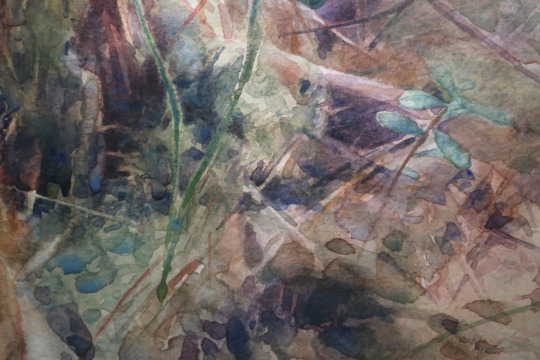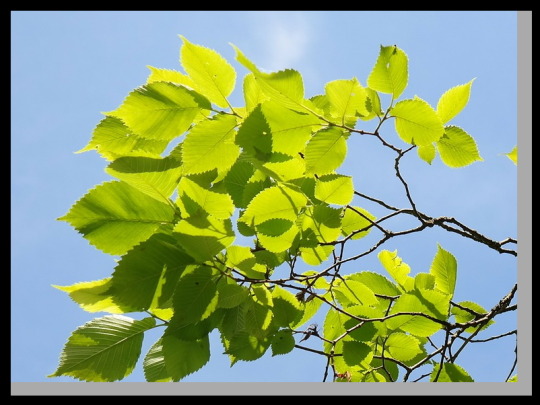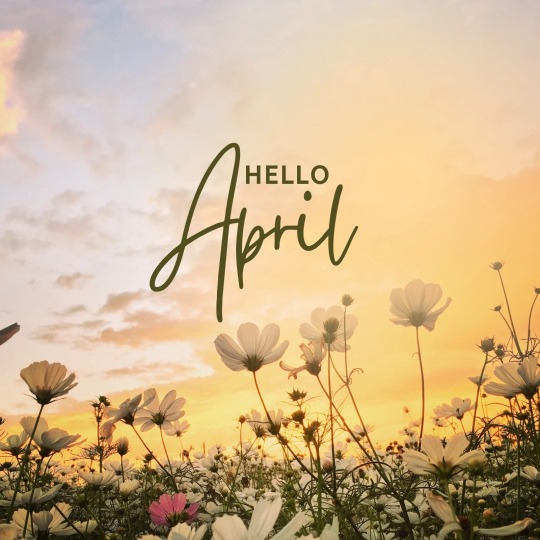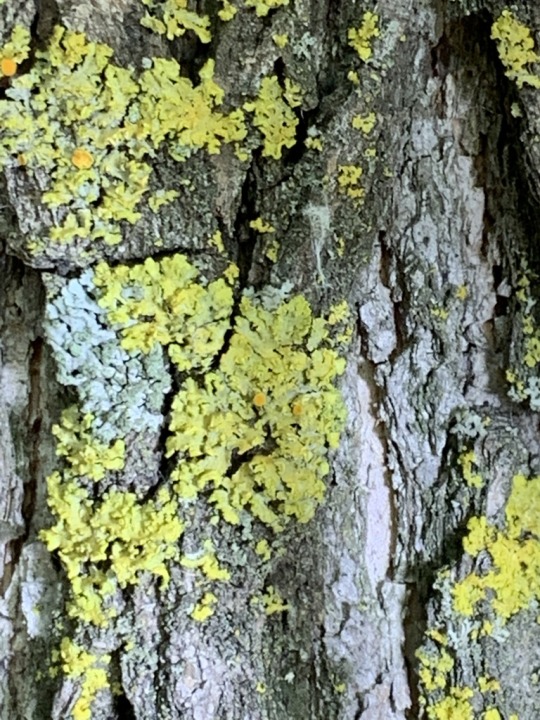#human nature 2024
Text




En långsam återgång, akvarell, 36x26,5 cm
Här är mitt andra porträtt av en stubbe till sommarens utställning på Laxholmen Kulturhus.
I fotona med närbilder kan ni se att det som i helheten kanske ser ut som detaljer egentligen inte är mycket mer än färgrinningar, streck och fläckar.
...
A slow return, watercolour, 36x26,5 cm
Here's my second portrait of a tree stump for this summer's exhibition at Laxholmen Kulturhus.
In the close-up photos you can see that what may look like details in the full picture really are little more than just paint runs, lines and splotches.
#laxholmen kulturhus#human nature 2024#skog#natur#akvarell#konst#måleri#forest#nature#protect nature#watercolour#watercolor#watercolor painting#watercolor art#landscape art#aquarelle#acuarela#aquarela#acquerello#ακουαρέλα#suluboya#akwarela#акварель#水彩#peace#petter brorson edh
57 notes
·
View notes
Text
Ah yes the four houses, corresponding with the four types of students
Sports
Brains
Arts
And, of course, nepo babies
#the nature of humanity is such that every once in a while we reinvent hogwarts houses#yes i know houses are a real thing in the english school system but the colorcoding the specific traits and the chosen animals?#big hp energy#red house chosen trait so funny tbfh#also violet house perfect speaks to me#kuroshitsuji#black butler#black butler: public school arc#can't believe I'm back on my kuroshitsuji bullshit in the year of our lord 2024 smh#STILL fucking unwell about Sebastian too no less#jess not beating the cringefail allegations fr#anime#ciel phantomhive#sebastian michaelis#jess talks
276 notes
·
View notes
Text
totality was breathtaking. truly a wild experience.
#eclipse 2024#literally walked out of my office and on to our town green to meet hubby and friends#had a local hot dog#and watched nature do its thing#crazy to think how humans have experienced totality over the course of our existance
38 notes
·
View notes
Text
Absolutely No Regrets!
#Madonna#2024#Celebration Tour#Human Nature#Absolutely No Regrets#Madonna 2024#Queen Of Pop#The Celebration Tour
16 notes
·
View notes
Text






Happy New Year 2024
#happy new year#happy new year 2024#new years day#celebration#celebrate#party#fireworks#sparklers#nature#human nature#people being people
12 notes
·
View notes
Text
Preserving Saskatoon's Urban Forest

View On WordPress
#action#April 26#April 29#biodiversity#Blairmore Sector Plan Report#Blogger#Canada#City Nature Challenge#City Nature Challenge Saskatoon CNC YXE 2024#climate change#communities#conservation#Conservation Status#directions#donation#Earth#ecosystems#enhance#Facebook Group Page#forest#forests#Friends of the Saskatoon Afforestation Areas#George Genereux Urban REgional Park#Goldenrod Gall Fly#Google Maps#Green Our Cities#Human Activity#imperiled#interconnectedness#International Peace
0 notes
Text
The Ultimate Guide to Software Tools for Nonprofits - Technology Org
New Post has been published on https://thedigitalinsider.com/the-ultimate-guide-to-software-tools-for-nonprofits-technology-org/
The Ultimate Guide to Software Tools for Nonprofits - Technology Org
Every day, we think of new ways technology can help humanity. While we are opening the new horizons of AI and machine learning, we shouldn’t forget how technology can help the previous concepts. Every nonprofit organization continues to face difficult challenges and needs definite help in streamlining its budget and resources. That’s where software tools can be a huge blessing for NPOs.
Business card exchange – illustrative photo. Image credit: Van Tay Media via Unsplash, free license
Common challenges faced by non-profit organizations include budget allocations, generating new leads, and reaching out to new audiences. God knows what not! It is not only beneficial but extremely crucial for them to do focused fundraising for the sake of the needy.
In this article, I will dive into the software needs of NPOs to help them drive toward their immediate goals as soon as possible.
Understanding Nonprofit Needs
As mentioned earlier, Non-profits face a different set of difficulties and challenges when compared with for-profit businesses. They must balance operational efficiency with current mission-driven goals. Especially when offered with way too less human resources, as is with most of the nonprofit organizations.
The software tools for nonprofit organizations must be pocket-friendly, offering features specific to the organization’s nature. Not to forget the necessity of being user-friendly to a range of people. So, think about making a checklist of the current needs and requirements of your organization so that you can look for the tool with better clarity. Don’t forget that most of you might be on a super tight budget.
One thing that’s going to be common with all the NPOs is to boost fundraisers and propagate crowdfunding channels. That’s precisely what I am going to help you with. By the time you reach the end of this piece, you will have a better understanding of your own goals.
Categories of Software Tools for Nonprofits
Now, there are multiple categories of software tools for Nonprofits. Some might be looking for donation software, and others might be in need of a great outreach tool. If you have no idea whether you need volunteer management or any of the tools I have mentioned, just stick with me for a few more minutes-
Donation and Fundraising Software
Donation software allows you to track the source of donations and amounts, as well as manage and even engage with the donors. This can be a huge leap for your non profit organization. Once your fundraising has started, you can streamline the revenue spending process and support your needs in a far more meaningful way.
There are many such software in the market, but you should only check the top donation software. Donorbox is a personal recommendation in the fundraising scene. With its robust features and great UX/UI, all your donations will be properly tracked and managed.
Communication and Outreach Tools
Obviously, if you want more people to know about your non-profit you need to reach out to as much as a bigger audience as you are able to. With restricted resources, the same becomes a little tricky and to be fair, quite difficult to do. That’s where social media and outreach tools can help you a great deal.
Celebrate your wins on Instagram, connect with similar NGOs on X (previously Twitter) and maintain a strong presence on all of the platforms. There are so many people actively looking for ads to help NGOs as not many can do it themselves. Bridge the gap between the donor and you. Run ads, reach out to celebrities and social media influences for additional support. The scope is truly endless.
Do not underestimate the power of emails. Even in 2024, it is one of the most revenue-generation business models for many businesses. Simply emailing the right donors will skyrocket your NGO like nothing else. You can ask the rich of businesses to be your sponsors, and to your surprise, many will also do it gladly to maintain a good reputation on the internet.
Project and Volunteer Management Software
If you are an international or even an interstate organization, God bless your soul by manually managing the volunteer workforce. Needless to say, volunteers are the backbone of any non-profit organization. That’s why a good Project and Volunteer Management software will ensure you keep track of all the people, what tasks they are assigned, and whether the project gets completed on time.
Financial Management Tools
Financial transparency and accountability are paramount for any organization and even more important if you are a non-profit. With a limited budget and limited resources, having a master financial management tool like MoneyMinder and Freshbooks will not only do the correct financial reporting but also regulate the revenue flow making the organization more efficient.
Implementing Software Solutions
After you have recognized your NGOs need and chosen the right one for your organization, the last step is to integrate and implement the software. This might be technical for many, so it’s best if you let someone experienced implement the software. It will require them to feed the software existing data and information, which can take a little time. However, once done, you have no idea how easy your processes are going to be.
Conclusion
I hope the article helped you with choosing the right category of software for your non profit organization. After thorough research and brainstorming, you will get the right fit for you. Fundraising software are the new cool and once you get the hang of them, you are never coming back to the ordinary world.
#2024#ai#Article#bridge#Business#communication#data#deal#easy#efficiency#Experienced#Features#financial#Fintech news#freshbooks#fundraising#gap#how#human#human resources#instagram#Internet#it#learning#LESS#Machine Learning#management#media#nature#new horizons
0 notes
Text
The month of April 2024: holidays, folklore and traditions
“April cold with dripping rain
Willows and lilacs brings again,
The whistle of returning birds,
And trumpet-lowing of the herds.”
–Ralph Waldo Emerson (1803–82)
By April, spring has finally sprung, and if we’re lucky, the weather will reflect that.
We hope that your sky is bright and clear and your grass is growing green.
In celebration, check out the month’s holidays, fun facts, monthly pink…

View On WordPress
#2024#April#Europe#folklore#holidays#human#international#nature#news#oddities#people#stories#traditions#world
0 notes
Text
In some ways I feel like lockdown never really ended where I live.
Sure, everything is open again, in terms of pubic services and social spaces.
But I feel like socially, people are still more so in bubbles than they used to be.
As someone in a bubble of one, obviously this isn't ideal.
At this point part of me feels like the world will never get back to normal. It's hard, man. People actually got used to that and rewrote their personalities to reflect it, or something?
I feel like I'm at step zero of doing something to fix it, too.
I don't know what option there even is to fix it. How do you make social connections when your entire pool of potential connections is actively removing themselves from possibility? Even if they do go to something socially, everyone seems to bring a friend and not want to branch out.
I'm an extrovert and this is really hard. All of the ways I know to get around the situation don't really have an in anymore either.
And the older I get too, the harder I think it's probably going to be - on my darker days especially.
I don't want to live in a society of robots.
#society#thoughts#2020s#2024#lockdown#social changes#extroverts#bubbles#ai#robots#human nature#text post
1 note
·
View note
Text
#Rose Festival Chandigarh 2024: Blooming Extravaganza#The Rose Festival Chandigarh 2024 is a celebration of nature’s beauty and human creativity#combining floral splendor#cultural richness#and community engagement. With its roots traced back through the years#this festival has evolved into a vibrant showcase of roses and a melting pot of diverse cultural experiences.#Rose Garden Chandigarh Highlights#Particulars#Details#Name#Rose Festival#Venue#Zakir Hussain Rose Garden#Jan Marg#16B#Sector 16#Chandigarh#160015#Dates#February 2024 (Tentative)#Timings#10 AM Onwards#Entry Fees#Free#Nearest Railway Station#Nearest Airport#Rose Garden Chandigarh Date and Venue#located at Jan Marg#Chandigarh (160015)#is gearing up for its upcoming event tentatively scheduled for February 2024. The festivities are expected to commence at 10 AM onwards.
0 notes
Text

Lämnad ensam, akvarell, 17x12 cm
Förra torsdagen blev mitt deltagande i sommarutställningen 2024 på Laxholmen Kulturhus i Munkfors officiellt tillkännagiven. Jag är väldigt tacksam för inbjudan!
Temat för utställningen är Human Nature, och jag har en tydlig idé av hur jag ska tolka temat. Jag är redo att börja jobba med tavlorna. Det här kommer att bli kul!
Den här lilla målningen är en studie för en något större akvarell.
...
Left alone, watercolour, 17x12 cm
Last Thursday, my participation in the 2024 summer exhibition at Laxholmen Kulturhus in Munkfors became official. I'm very grateful for the invitation!
The theme of the exhibition is Human Nature, and I have a clear idea of how I will interpret this theme. I'm ready to start working on the paintings. This will be fun!
This little painting is a study for a slightly larger watercolour.
#laxholmen kulturhus#human nature 2024#skog#natur#akvarell#konst#måleri#forest#nature#watercolour#watercolor painting#watercolor art#landscape art#aquarelle#acuarela#aquarela#acquerello#ακουαρέλα#suluboya#akwarela#акварель#水彩#peace#petter brorson edh
81 notes
·
View notes
Text
#ufolovers#new york ss 2024 street style: irina shayk#human nature#human humanos ember#ancient aliens
0 notes
Text
From the Freedom Flotilla, April 27 2024:
On Thursday afternoon, the Freedom Flotilla Coalition was contacted by the Guinea Bissau International Ships Registry (GBISR), requesting an inspection of our lead ship – Akdenez. This was a highly unusual request as our ship had already passed all required inspections; nevertheless, we agreed. The inspector arrived on Thursday evening. On Friday afternoon, before the inspection was completed, the GBISR, in a blatantly political move, informed the Freedom Flotilla Coalition that it had withdrawn the Guinea Bissau flag from two of the Freedom Flotilla’s ships, one of which is our cargo ship, already loaded with over 5000 tons of life-saving aid for the Palestinians of Gaza.
In its communication informing us of this cancelation, the GBISR made specific reference to our planned mission to Gaza. It also made several extraordinary requests for information, including confirmation of the ships’ destination, any potential additional port calls, and the discharge port for humanitarian aid and estimated arrival dates and times. It further demanded a formal letter explicitly approving the transportation of humanitarian aid and a complete manifest of the cargo.
Again, this is a highly unusual move from a flagging authority. Normally, national flagging authorities concern themselves only with safety and related standards on vessels bearing their flag, and are not concerned with the destination, route, cargo manifests or the nature of a specific voyage. Just like when you register your car, the authorities don’t require you to detail to them every place you are going to go with the car.
Sadly, Guinea-Bissau has allowed itself to become complicit in Israel’s deliberate starvation, illegal siege and genocide of Palestinians in Gaza. Israel is showing the world the extent to which it will go to deny Palestinians the aid they need to stay alive, in direct contravention of International Humanitarian Law, UN Security Council resolutions, and two orders of the International Court of Justice.
[...] without a flag, we cannot sail. But, this is not the end. Israel cannot and will not crush our resolve to break its illegal siege and reach the people of Gaza. The people of Gaza and all of Palestine remain steadfast under the most horrific, unimaginable conditions. We take strength from their incredible, inexplicable ability to maintain their humanity, dignity and hope when the world has given them no reason to do so.
It is our responsibility to keep that hope alive. WE WILL SAIL.
The Freedom Flotilla, which was set to depart from Turkey on the 27th of April with 5000 tons of life-saving aid, has now been delayed because Israel and the United States has pressured Guinea Bissau to withdraw its flag from the Flotilla's lead ship.
Seeing as how their tactics worked on Guinea Bissau, organizers now fear that Israel and the US will exert the same pressure on whichever country the Freedom Flotilla attempt to register their ship under next.
To help the Freedom Flotilla reach Gaza, please keep an eye out for further updates from the organizers. Right now, as of April 27th, they're asking people to help boost their visibility, and to donate to their member campaigns.
For more info, see their webpage.
#from the river to the sea palestine will be free#free palestine#palestine#israel#gaza#freedom flotilla
5K notes
·
View notes
Text
(not so) friendly reminder that a non-exaustive list of war crimes that isreal has committed is:
Wilful killing
Torture or inhumane treatment, including biological experiments
Wilfully causing great suffering, or serious injury to body or health
Extensive destruction and appropriation of property, not justified by military necessity and carried out unlawfully and wantonly
Intentionally directing attacks against the civilian population as such or against individual civilians not taking part in direct hostilities
Intentionally directing attacks against civilian objects which are non-military
Intentionally directing attacks against humanitarian assistance
Intentionally launching an attack knowing that it will cause loss of life, injury or harm to civilians or civil properties
Intentionally launching an attack knowing it will cause significant damage to the natural environment without necessity
Attacking or bombarding, by whatever means, towns, villages, dwellings or buildings which are undefended and which are not military objectives
Intentionally directing attacks against buildings dedicated to religion, education, art, science, charitable purposes, historic monuments, hospitals, and places where the wounded are collected, assuming they are not military objectives
Employing asphyxiating, poisonous, or other gasses, and all analogous liquids, materials or devices
Employing weapons, projectiles, and material and methods or warfare which are of a nature to cause superfluous injury or unnecessary suffering
Intentionally directing attacks against buildings, material, medical units and transport and personnel
Intentionally using starvation of civilians as a method of warfare by depriving them of objects indispensable to their survival
If you still think this is isreal defending itself, you're ignoring the signs. This is a genocide. These are war crimes. More than 25,000 civilians have been murdered. This is not okay.
Edit:
For all the people asking me for a source, here is a list:
https://www.hrw.org/news/2023/12/18/israel-starvation-used-weapon-war-gaza
Any of Bisan's videos/writings. There are so many people on the ground in Gaza who are documenting this. Stay safe and stay educated
#from the river to the sea palestine will be free#free palestine 🇵🇸#this is a genocide#isreal is a terrorist state#immediate ceasefire#these are war crimes#ceasefire#ceasfire now
4K notes
·
View notes
Text
CNC YXE 2024 host: Friends of the Saskatoon Afforestation Areas

View On WordPress
#action#beauty#City Nature Challenge#CNC YXE 2024#communities#corridors#Earth#footprints#Friends of the Saskatoon Afforestation Areas#George Genereux Urban REgional Park#harmony#hope#humanity#interconnectedness#Life on Land#mass extinction#native species#Nature#Nutana Varsity View Community Association#preservation#recycle#reduce#renewal#resilience#reuse#Reverence#Richard St. Barbe Baker AFforestation ARea#Rosewood Varsity View Community Association#Saskatchewan#Saskatoon
0 notes
Text
Since the 1960s, the world has seen a spike in the number of natural disasters, largely due to rising sea levels and an ever gradually increasing global surface temperature.
The good news? We’re getting better at helping each other when disasters strike.
According to a recent study from Our World In Data, the global toll from natural disasters has dramatically dropped in the last century.
“Low-frequency, high-impact events such as earthquakes and tsunamis are not preventable, but such high losses of human life are,” wrote lead authors Hannah Ritchie and Pablo Rosado.
To conduct their research, Ritchie and Rosado gathered data from all geophysical, meteorological, and climate-related disasters since 1900. That includes earthquakes, volcanic activity, landslides, drought, wildfires, severe storms, and mass floods.
In the early-to-mid 20th century, the average annual death toll from disasters was very high, often climbing to over a million.
For example, the study cites that in 1931, 2.7 million people died from the Yangtze–Huai River floods. In 1943, 1.9 million died from the Bangladeshi famine of 1943. Even low-frequency events had extreme death tolls.
“In recent decades we have seen a substantial decline in deaths,” Ritchie and Rosado observed. “Even in peak years with high-impact events, the death toll has not exceeded 500,000 since the mid-1960s.”
Why has the global death toll from disasters dropped?
There are a number of factors at play in the improvement of disaster aid, but the leading component is that human beings are getting better at predicting and preparing for natural disasters.
“We know from historical data that the world has seen a significant reduction in disaster deaths through earlier prediction, more resilient infrastructure, emergency preparedness, and response systems,” Ritchie and Rosado explained in their study.
On April 6, [2024],a 7.2 magnitude earthquake rocked the city of Hualien in Taiwan. Days later, as search and rescue continues, the death toll currently rests at 16.
Experts have praised Taiwan for their speedy response and recovery, and attributed the low death toll to the measures that Taiwan implemented after an earthquake of similar strength hit the city 25 years earlier. Sadly, on that day in 1999, 2,400 people died and 11,000 were injured.
In an interview with Al Jazeera, Wang Yu — assistant professor at National Taiwan University — said that event, known as the Chi-Chi earthquake, revolutionized the way Taiwan approached natural disasters.
“There were lots of lessons we learned, including the improvement of building codes, understanding earthquake warning signs, the development and implementation of earthquake early warning (EEW) systems and earthquake education,” said Wang.
Those same sensors and monitoring systems allowed authorities to create “shakemaps” during Hualien’s latest earthquake, which helped them direct rescue teams to the regions that were hit the hardest.
This, in conjunction with stronger building codes, regular earthquake drills, and public education campaigns, played a huge role in reducing the number of deaths from the event.
And Taiwan’s safeguards on April 6 are just one example of recent measures against disasters. Similar models in strengthening prediction, preparedness, and recovery time have been employed around the world when it comes to rescuing victims of floods, wildfires, tornados, and so on.
What else can we learn from this study?
When concluding the findings from their study, Ritchie and Rosado emphasized the importance of increasing safety measures for everyone.
Currently, there is still a divide between populations with high gross national income and populations living in extreme poverty.
Even low-income countries that infrequently have natural disasters have a much higher death rate because they are vulnerable to collapse, displacement, and disrepair.
“Those at low incomes are often the most vulnerable to disaster events; improving living standards, infrastructure, and response systems in these regions will be key to preventing deaths from natural disasters in the coming decades,” surmised Ritchie and Rosado.
“Overall development, poverty alleviation, and knowledge-sharing of how to increase resilience to natural disasters will therefore be key to reducing the toll of disasters in the decades to come."
-via GoodGoodGood, April 11, 2024
#good news#hope#climate change#hope posting#climate news#climate crisis#climate anxiety#climate emergency#natural disasters#disasters#earthquake#wildfire#hurricane#cw death#taiwan#tsunamis#building construction#climate action#climate hope
378 notes
·
View notes